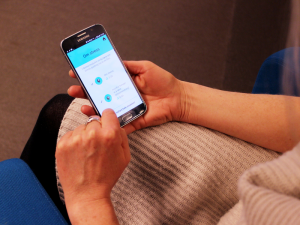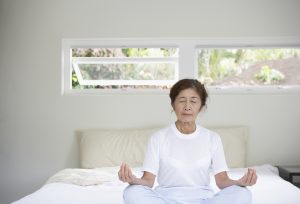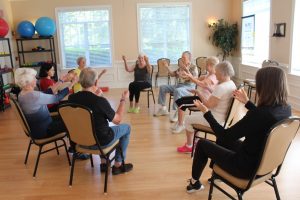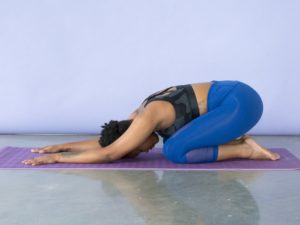Improve the Psychological and Physical Health of Myeloproliferative Neoplasm Patients with a Smartphone Mindfulness App
By John M. de Castro, Ph.D.
“Even with an app, mindfulness takes practice. Like playing an instrument or a sport, the more you practice, the better you get and the more you get out of it. . . Whatever you try, mindfulness training is considered very safe, and has a good chance of increasing your happiness and peacefulness, and reducing your depression, anxiety, and stress.” – James Cartreine
“Myeloproliferative Neoplasms (MPNs) are blood cancers that occur when the body makes too many white or red blood cells, or platelets” (Cancer Support Community). It typically occurs in older adults and is fairly rare (1-2 cases/100,000 per year) and has a very high survival rate. It produces a variety of psychological and physical symptoms including fatigue, anxiety, depression, pain, and sleep disturbance, reduced physical, social, and cognitive functioning resulting in a reduced quality of life.
Mindfulness training has been shown through extensive research to be effective in improving physical and psychological health including fatigue, anxiety, depression, pain, and sleep disturbance, and improves physical, social, and cognitive functioning as well as quality of life in cancer patients. The vast majority of the mindfulness training techniques, however, require a trained therapist. This results in costs that many patients can’t afford. In addition, the participants must be available to attend multiple sessions at particular scheduled times that may or may not be compatible with their busy schedules and at locations that may not be convenient.
As an alternative, Apps for smartphones have been developed. These have tremendous advantages in decreasing costs, making training schedules much more flexible, and eliminating the need to go repeatedly to specific locations. But the question arises as to the effectiveness of these Apps in relieving the psychological and physical symptoms of cancer and improving their quality of life.
In today’s Research News article “Smartphone-Based Meditation for c: Feasibility Study to Inform Future Trials.” (See summary below or view the full text of the study at: https://www.ncbi.nlm.nih.gov/pmc/articles/PMC6658299/), Huberty and colleagues recruited Myeloproliferative Neoplasm Patients and randomly assigned them to either to receive 4 weeks of mindfulness training including 10 minutes of meditation per day via a smartphone app (“Calm”) followed by mindfulness training via another smartphone app (“10% Happier App”), the 2 apps in reverse order, education about Myeloproliferative Neoplasm followed by “10% Happier App”, or education followed by “Calm” app. They were measured before and after training and for Myeloproliferative Neoplasm symptoms, fatigue, anxiety, depression, pain, sleep disturbance, sexual function, health, and quality of life.
They found that the participants used the “Calm” App to a significantly greater extent and enjoyed it more than the “10% Happier” App. But following mindfulness training with both apps there were significant improvements. For the “10% Happier” App after training there were significant increases in health, and mental health and decreases in fatigue, anxiety, depression, and sleep disturbance. For the “Calm” App after training there were significant increases in health, and decreases in Myeloproliferative Neoplasm symptoms, fatigue, depression, vaginal discomfort, and sleep disturbance.
This was a relatively small pilot study that demonstrated the feasibility and efficacy of mindfulness training smartphone apps for the treatment of Myeloproliferative Neoplasm patients. It would appear that the “Calm” App is the preferred app. But both were effective in producing benefits. The improvements were significant and helpful in relieving the suffering of the patients. This is important as the use of smartphone apps makes it easier, more convenient, and more cost effective to provide mindfulness training to a wide swath of Myeloproliferative Neoplasm patients thus maximizing the utilization of mindfulness training for the improvement of the symptoms of patients with Myeloproliferative Neoplasm.
So, improve the psychological and physical health of myeloproliferative neoplasm patients with a smartphone mindfulness app.
“So how can this practice of mindfulness help people with cancer? . . . Routinely, we see large and meaningful improvements in mood, stress levels, depression, anger, worry, and rumination. We also see people having an increased sense of meaning and purpose in life, better sleep, and more energy, as well as displaying biological changes like a healthier pattern of stress hormones and less inflammation in the immune system.” – Linda Carlson
CMCS – Center for Mindfulness and Contemplative Studies
This and other Contemplative Studies posts are also available on Google+ https://plus.google.com/106784388191201299496/posts and on Twitter @MindfulResearch
Study Summary
Jennifer Huberty, Ryan Eckert, Linda Larkey, Jonathan Kurka, Sue A Rodríguez De Jesús, Wonsuk Yoo, Ruben Mesa. Smartphone-Based Meditation for Myeloproliferative Neoplasm Patients: Feasibility Study to Inform Future Trials. JMIR Form Res. 2019 Apr-Jun; 3(2): e12662. Published online 2019 Apr 29. doi: 10.2196/12662
Abstract
Background
Myeloproliferative neoplasm (MPN) patients often report high symptom burden that persists despite the best available pharmacologic therapy. Meditation has gained popularity in recent decades as a way to manage cancer patient symptoms.
Objective
The aim of this study was to examine the feasibility of 2 different consumer-based meditation smartphone apps in MPN patients and to examine the limited efficacy of smartphone-based meditation on symptoms compared with an educational control group.
Methods
Patients (n=128) were recruited nationally through organizational partners and social media. Eligible and consented patients were enrolled into 1 of 4 groups, 2 of which received varying orders of 2 consumer-based apps (10% Happier and Calm) and 2 that received one of the apps alone for the second 4 weeks of the 8-week intervention after an educational control condition. Participants were asked to perform 10 min of meditation per day irrespective of the app and the order in which they received the apps. Feasibility outcomes were measured at weeks 5 and 9 with a Web-based survey. Feasibility outcomes were acceptability, demand, and limited efficacy for depression, anxiety, pain intensity, sleep disturbance, sexual function, quality of life, global health, and total symptom burden.
Results
A total of 128 patients were enrolled across all 4 groups, with 73.4% (94/128) patients completing the intervention. Of the participants who completed the 10% Happier app, 61% (46/76) enjoyed it, 66% (50/76) were satisfied with the content, and 77% (59/76) would recommend to others. Of those who completed the Calm app, 83% (56/68) enjoyed it, 84% (57/68) were satisfied with the content, and 97% (66/68) would recommend to others. Of those who completed the educational control, 91% (56/61) read it, 87% (53/61) enjoyed it, and 71% (43/61) learned something. Participants who completed the 10% Happierapp averaged 31 (SD 33) min/week; patients completing the Calm app averaged 71 (SD 74) min/week. 10% Happier app participants saw small effects on anxiety (P<.001 d=−0.43), depression (P=.02; d=−0.38), sleep disturbance (P=.01; d=−0.40), total symptom burden (P=.13; d=−0.27), and fatigue (P=.06; d=−0.30), and moderate effects on physical health (P<.001; d=0.52). Calm app participants saw small effects on anxiety (P=.29; d=−0.22), depression (P=.09; d=−0.29), sleep disturbance (P=.002; d=−0.47), physical health (P=.005; d=0.44), total symptom burden (P=.13; d=−0.27), and fatigue (P=.13; d=−0.27). Educational control participants (n=61) did not have effects on any patient-reported outcome except for a moderate effect on physical health (P<.001; d=0.77).
Conclusions
Delivering meditation via the Calm app is feasible and scored higher in terms of feasibility when compared with the 10% Happier app. The Calm app will be used to implement a randomized controlled trial, testing the effects of meditation on symptom burden in MPNs.









